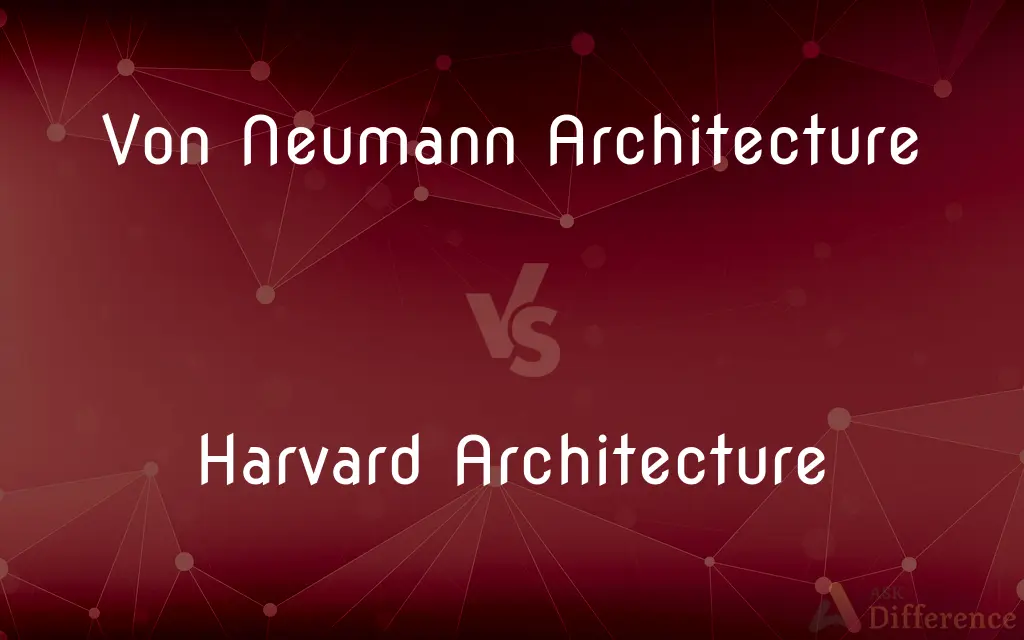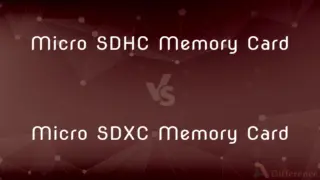Von Neumann Architecture vs. Harvard Architecture — What's the Difference?
By Tayyaba Rehman — Published on January 30, 2024
Von Neumann Architecture uses the same memory for data and instructions, whereas Harvard Architecture has separate memories for data and instructions.

Difference Between Von Neumann Architecture and Harvard Architecture
Table of Contents
ADVERTISEMENT
Key Differences
Von Neumann Architecture, named after mathematician John von Neumann, features a single memory space for storing both instructions and data. In contrast, Harvard Architecture separates the storage and handling of CPU instructions and data, using two distinct memory blocks.
In Von Neumann Architecture, both data and program instructions are accessed from the same memory path, leading to a potential bottleneck. Harvard Architecture, by having separate paths, allows simultaneous access to instructions and data, potentially increasing efficiency.
The Von Neumann model is simpler and more commonly used in general-purpose computers. Harvard Architecture, with its separated memory, is often found in specialized systems like DSPs (Digital Signal Processors) where speed is crucial.
Von Neumann Architecture is more flexible in terms of programming, as it allows self-modifying code. Harvard Architecture’s separation of memory makes self-modifying code more complex and less feasible.
While Von Neumann Architecture is cost-effective and easy to implement, Harvard Architecture offers performance advantages in specific applications, particularly where processing speed and efficiency are prioritized.
ADVERTISEMENT
Comparison Chart
Memory Structure
Single memory for data and instructions
Separate memories for data and instructions
Access Method
Sequential access to data and instructions
Parallel access to data and instructions
Typical Usage
General-purpose computing
Specialized applications like DSPs
Flexibility in Programming
Allows self-modifying code
Less suitable for self-modifying code
Performance and Efficiency
Can face bottleneck issues
Higher efficiency and speed
Compare with Definitions
Von Neumann Architecture
Common in general-purpose computers due to its flexibility and ease of implementation.
Von Neumann Architecture supports a wide range of applications and software.
Harvard Architecture
Often used in specialized applications, like digital signal processing.
DSP systems frequently utilize Harvard Architecture for optimal performance.
Von Neumann Architecture
Allows self-modifying code, enhancing programming flexibility.
Von Neumann Architecture's design facilitates dynamic program modifications.
Harvard Architecture
Offers performance advantages in applications requiring high efficiency.
Harvard Architecture is chosen for tasks demanding fast and efficient data handling.
Von Neumann Architecture
A computer architecture where a single memory stores both data and instructions.
Most personal computers use Von Neumann Architecture for their operations.
Harvard Architecture
Uses separate memory banks for storing instructions and data.
Harvard Architecture is ideal for systems where processing efficiency is critical.
Von Neumann Architecture
Can lead to a bottleneck due to the shared use of memory for data and instructions.
The Von Neumann bottleneck is a limitation in data processing speed.
Harvard Architecture
Allows simultaneous access to instructions and data, increasing speed.
In Harvard Architecture, parallel access enhances data processing capabilities.
Von Neumann Architecture
Characterized by the use of a single sequential memory to execute instructions.
Von Neumann Architecture's design simplicity makes it popular in computing.
Harvard Architecture
Less flexible for programming due to separate instruction and data memory.
Self-modifying code is less practical in Harvard Architecture systems.
Common Curiosities
Is Harvard Architecture more expensive to implement than Von Neumann?
Generally, yes, due to its more complex memory and control systems.
What is a common application of Harvard Architecture?
It's frequently used in Digital Signal Processing (DSP) systems.
How does Harvard Architecture improve processing speed?
By allowing parallel access to data and instructions from separate memories.
Can Von Neumann Architecture lead to bottlenecks?
Yes, due to sequential access to a single memory for both data and instructions.
Which architecture is more common in personal computers?
Von Neumann Architecture is more commonly used in personal computers.
Does Von Neumann Architecture support self-modifying code?
Yes, its structure allows for self-modifying code.
What is the key feature of Von Neumann Architecture?
It uses the same memory for both program instructions and data storage.
Does Harvard Architecture have any programming limitations?
Its separation of memory can make programming more complex and less flexible.
How do the two architectures differ in memory access?
Von Neumann uses sequential access, while Harvard allows parallel access.
Can either architecture be used in mobile devices?
Yes, both can be adapted for use in mobile devices, depending on the specific requirements.
Why is Von Neumann Architecture considered simpler?
Its single-memory approach is simpler to design and implement.
Can Harvard Architecture handle high-speed computing tasks better?
Yes, its parallel memory access is suited for high-speed computing needs.
Is Von Neumann Architecture suitable for all types of software?
It's versatile and can support a wide range of software applications.
Can Harvard Architecture use the same memory for data and instructions?
No, it strictly separates instruction and data memories.
What are the cost implications of each architecture?
Von Neumann is generally more cost-effective, while Harvard can be more expensive.
Share Your Discovery

Previous Comparison
Micro SDHC Memory Card vs. Micro SDXC Memory Card
Next Comparison
Buffet vs. La CarteAuthor Spotlight
Written by
Tayyaba RehmanTayyaba Rehman is a distinguished writer, currently serving as a primary contributor to askdifference.com. As a researcher in semantics and etymology, Tayyaba's passion for the complexity of languages and their distinctions has found a perfect home on the platform. Tayyaba delves into the intricacies of language, distinguishing between commonly confused words and phrases, thereby providing clarity for readers worldwide.
















































